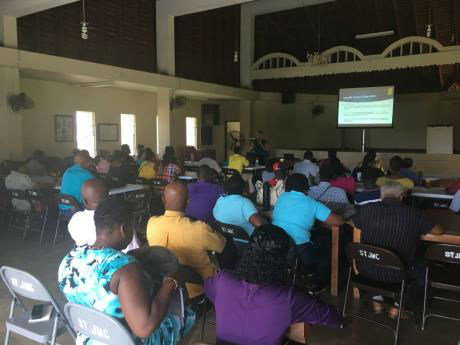FIFTEEN COMMUNITIES in the Upper Rio Minho Watershed (URMW) area of Clarendon are now better able to plan for climate impacts and hazards via the development of risk profiles, disaster risk reduction and climate change adaptation plans for each of them.
The plans were completed for the communities of Morgan’s Forest, Rock River, Kellits, Summerfield, Thompson Town, James Hill, Crooked River, Chapelton, Coxswain, Trout Hall, Pennants, Moores, Ritches, Brandon Hill, and Cumberland.
“We are very happy that the plans are now completed and that the communities already have teams in place that are committed to implementing them,” said Dr Winsome Townsend, project manager of the Adaptation Programme and Financing Mechanism (AP&FM) for the Pilot Programme for Climate Resilience (PPCR).
The plans were completed as a part of the deliverables of the five-year AP&FM project.
The 15-climate change and disaster risk reduction plans were a part of a bigger risk profile and climate change adaptation and disaster risk reduction plan being done for the Upper Rio Minho Watershed. The watershed was chosen as a focal area for the AP&FM because of its level of degradation, its exposure to climate change and its associated impacts, as well as its susceptibility to seismic activity.
Additionally, the basin is one of the major ground water producing basins in Jamaica with annual abstraction reaching about 400 million cubic metres (MCM) in one year (Climate Studies Group, 2014).
The risk profiles and climate change adaptation and disaster risk reduction plans were produced by a research team from Environmental Solutions Limited (ESL). The team used modelling scenarios from 2030, 2050 and 2080 climate research to inform the plans.
According to ESL’s project manager for this consultancy, Dr Theresa Rodriguez-Moodie, extensive consultations were held in the communities and with key stakeholder organisations such as the Office of Disaster Preparedness and Emergency Management, the National Environment and Planning Agency, the Clarendon Inter-Agency Network, the Water Resources Authority and Mines and Geology.
Workshops were also held to validate the findings of the studies and to discuss the recommended adaptation measures for the watershed and the communities in October.
PUBLIC AWARENESS KEY TO SUCCESSFUL RISK PLANNING
Rodriguez-Moodie noted that one of the main points consistently raised in these sessions was the issue of awareness and sensitisation.
“We can only implement actions towards a climate and disaster resilient watershed if we know what the issues are. Persons consulted felt that awareness and sensitization sessions towards climate change and its impacts should be done at different levels, focusing on the communities,” she said.
“Persons need to know what it means for their livelihood and how they can start planning. Many persons indicated that they can only afford to cope with the issues as they arise, whereas adaptation requires long term planning. In order to do so they feel if they are more educated and aware of the issues they will be better able to adapt,” she added.
Rodriquez-Moodie said that some of the adaptation measures being explored include revising zoning plans to reduce permitted development in flood zones, liquefaction zones and landslide zones.
Plans for long-term management will also include improving institutional and technical capacity; improving drainage infrastructure; addressing poor farming techniques; and encouraging the replanting of forest trees in the watershed.
Outside of the plans developed, the AP&FM has already started adaptation work in the watershed area. Some of the activities currently under implementation are:
– The installation of 1800 check dams to address flooding;
– Installation of 250 communal rainwater harvesting systems and rehabilitation of three rain ponds;
– Installation of 5 aquaponics systems in 5 communities;
– Reforestation of 15 hectares of land; and
– 50 hectares of Agro-Forestry.
“By helping with the restoration of the Upper Rio Minho Watershed the AP&FM is ensuring the water security of the island especially in the face of the longer droughts that we are seeing with climate change,” said Townsend.


